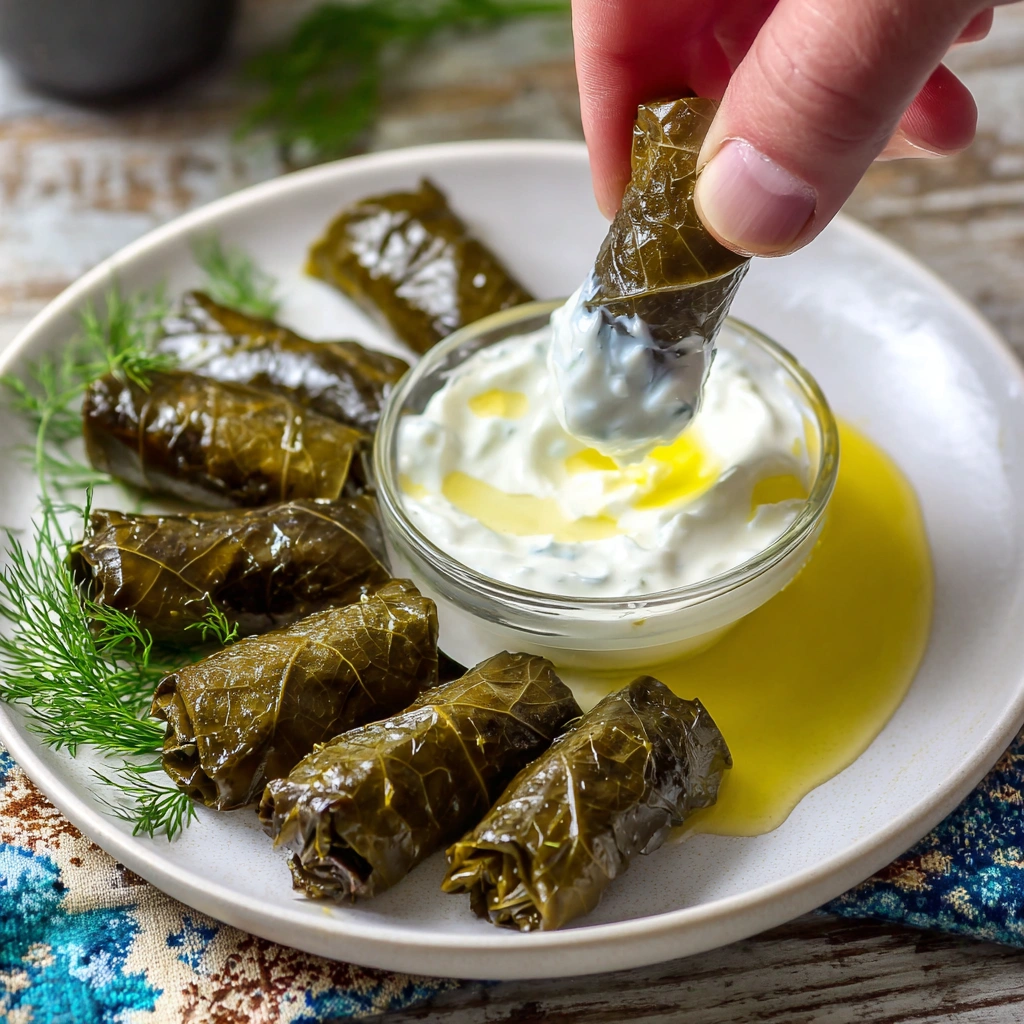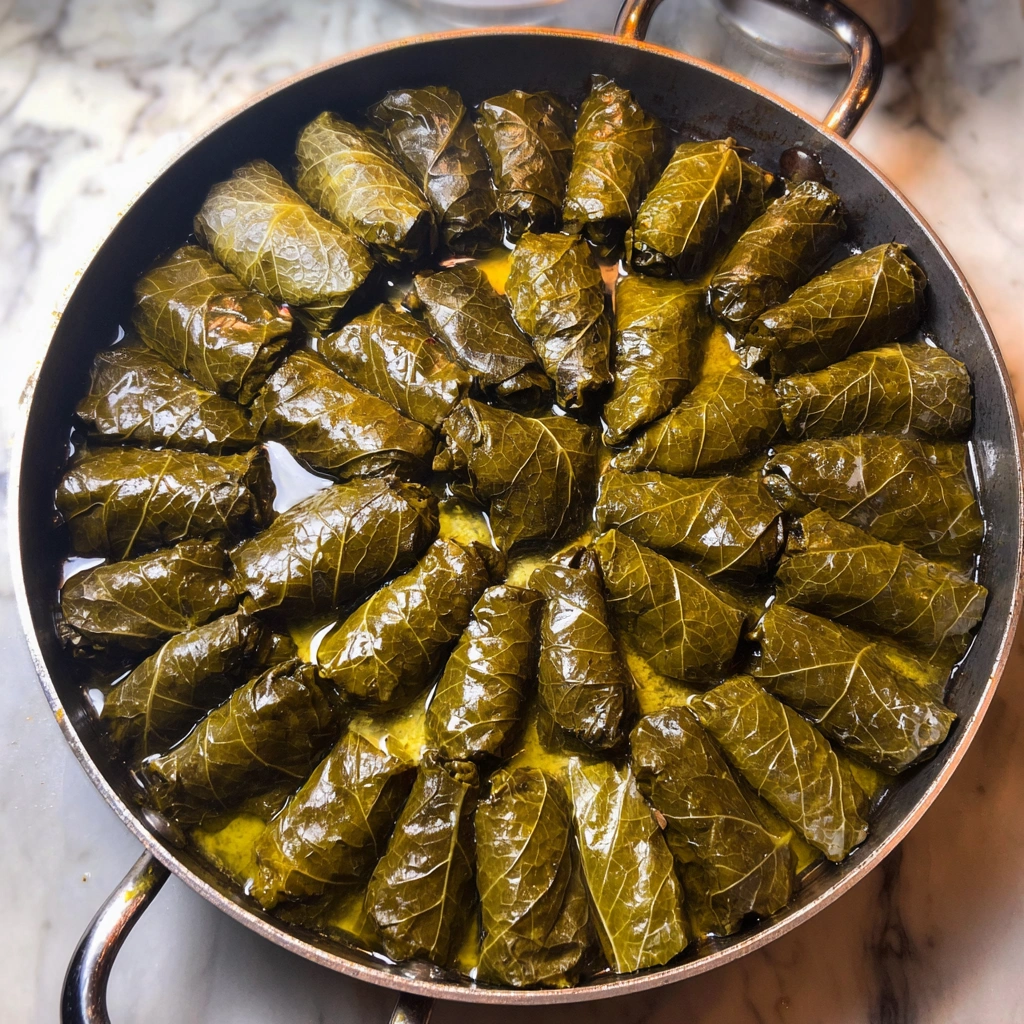Introduction
Dolmades, or stuffed grape leaves, are one of the most iconic dishes of Greek and Mediterranean cuisine. These tender little rolls are packed with fragrant rice, fresh herbs, and sometimes ground meat, then slowly cooked until meltingly soft in a lemony broth. Dolmades aren’t just food; they’re part of a centuries-old tradition that connects families, regions, and cultures across the Mediterranean. Whether you’ve tried them in a seaside taverna in Greece or at a family table, they always leave a lasting impression.
In this comprehensive guide, you’ll discover everything about dolmades—from their rich history and essential ingredients to the step-by-step process of rolling and cooking them like a pro. We’ll also cover variations, nutritional benefits, and how to store them for later. If you’re passionate about authentic flavors, don’t miss our Flaky Spanakopita Spiral for another beloved Greek dish that pairs beautifully with dolmades.
The History of Dolmades
Origins of Stuffed Grape Leaves
The word “dolma” comes from the Turkish verb dolmak, meaning “to be stuffed.” Stuffed grape leaves are believed to have originated in the Middle East and spread throughout the Ottoman Empire. Over centuries, the recipe was adapted in Greece, Lebanon, Armenia, and beyond, with each region adding its own touch.
Influence Across the Mediterranean
In Greece, dolmades are often vegetarian, focusing on fresh herbs and rice, while in Turkey or Lebanon, they may include ground lamb or beef. Despite the variations, the essence remains the same: tender grape leaves filled with a savory mixture and cooked with care.
Key Ingredients for Dolmades (Stuffed Grape Leaves)
Choosing the Right Grape Leaves
Grape leaves are the soul of dolmades. Fresh leaves picked in spring are soft and tender, but jarred grape leaves preserved in brine are more accessible year-round. Look for leaves that are medium-sized, without thick veins, for easy rolling.
Essential Herbs and Spices
The beauty of dolmades lies in their fragrant filling. Common herbs include parsley, dill, and mint, while onions and scallions add sweetness. Lemon juice gives them their signature brightness, and a drizzle of olive oil ties everything together.
Preparing the Grape Leaves
Fresh vs Jarred Leaves
Fresh leaves need to be blanched for a few minutes in boiling water to soften them. Jarred grape leaves, on the other hand, should be rinsed thoroughly to remove excess brine before use.
Blanching and Softening Techniques
If using fresh leaves, boil a large pot of salted water and dip the leaves in for 1–2 minutes. Transfer immediately to an ice bath to keep them supple and easy to roll.
Crafting the Dolmades Filling
Vegetarian Rice and Herb Mixture
The classic vegetarian filling is a mixture of short-grain rice, finely chopped onion, parsley, dill, and mint. Some recipes also add pine nuts or currants for sweetness.
Meat Variations for a Heartier Dish
In many regions, ground beef or lamb is added to the rice mixture. This variation creates a heartier dolma, often served warm with yogurt or avgolemono (egg-lemon sauce).
| Ingredient | Vegetarian Dolmades | Meat Dolmades |
|---|---|---|
| Grape Leaves | 60 leaves | 60 leaves |
| Rice | 1 ½ cups | 1 ½ cups |
| Onion | 1 | 1 |
| Herbs | Parsley, dill, mint | Parsley, dill |
| Protein | — | ½ lb ground beef/lamb |
| Olive Oil | ½ cup | ½ cup |
| Lemon | 2 | 2 |
Rolling Dolmades Perfectly
Step-by-Step Rolling Guide
- Lay one grape leaf shiny side down on a flat surface.
- Place 1 tsp of filling near the stem end.
- Fold in the sides, then roll tightly from bottom to top, like a burrito.
- Repeat until all filling is used.
Common Mistakes to Avoid
- Overstuffing: Rice expands during cooking, so use a small amount of filling.
- Loose rolling: Dolmades should be snug, but not too tight, or they may burst.
Cooking Dolmades (Stuffed Grape Leaves)
Simmering in Lemon Broth
Line the bottom of a pot with extra grape leaves to prevent sticking. Place dolmades seam-side down in tight rows. Cover with lemon juice, olive oil, and water until just submerged. Weigh them down with a plate to keep them intact. Simmer for 45–60 minutes until rice is tender.
Oven-Baked Dolmades Method
Alternatively, place dolmades in a baking dish, add lemon broth, cover with foil, and bake at 350°F for 1 hour. This method develops a slightly caramelized flavor.
Serving Suggestions and Pairings
Traditional Greek Accompaniments
Dolmades are often served as part of a meze platter alongside tzatziki, olives, feta, and bread. Pair them with ouzo or a crisp white wine for the full Greek experience.

Modern Twists and Fusion Ideas
Try serving dolmades with quinoa filling for a healthier twist, or pair them with roasted vegetables like our Greek Lemon Rice. For a heartier meal, don’t miss our Outrageously Delicious Greek Moussaka.
Nutritional Benefits of Dolmades
Health Benefits of Grape Leaves
Grape leaves are rich in fiber, low in calories, and a good source of vitamins A, C, and K.
Balanced Diet and Portioning
Dolmades provide a balance of carbs, healthy fats from olive oil, and protein (if meat is included). They make a nutritious option for light meals or snacks.
Storing and Reheating Dolmades
Refrigeration Tips
Store cooked dolmades in an airtight container with a splash of lemon juice and olive oil. They keep well for up to 5 days in the refrigerator.
Freezing Dolmades Without Losing Flavor
Place cooled dolmades in a freezer-safe container with parchment paper between layers. Freeze for up to 3 months. Thaw in the fridge overnight before reheating.
FAQs About Dolmades (Stuffed Grape Leaves)
PAA1: What are dolmades made of?
Dolmades are typically made with grape leaves wrapped around rice, herbs, and sometimes ground meat.
PAA2: Can you make dolmades vegetarian?
Yes, vegetarian dolmades are very common and use rice, dill, parsley, mint, and lemon juice.
PAA3: How long do dolmades last in the fridge?
They last up to 5 days when stored in an airtight container.
PAA4: Are dolmades served hot or cold?
They can be enjoyed warm with broth or cold as a refreshing appetizer.
PAA5: Can dolmades be frozen?
Yes, freeze for up to 3 months without losing flavor.
PAA6: What do you eat with dolmades?
Dolmades pair well with tzatziki, salads, and dishes like Mediterranean Chicken Gyros.
Conclusion
Dolmades (stuffed grape leaves) are a shining example of Greek hospitality and culinary tradition. Whether vegetarian or with meat, they bring together flavors of lemon, herbs, and tender grape leaves in every bite. By following this guide, you can prepare dolmades with confidence and enjoy them with your family. Don’t miss trying them alongside our Mediterranean Chicken Gyros for a complete Greek-inspired meal.

